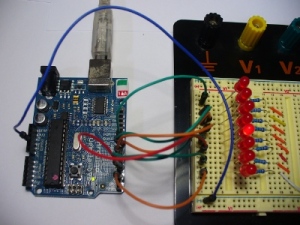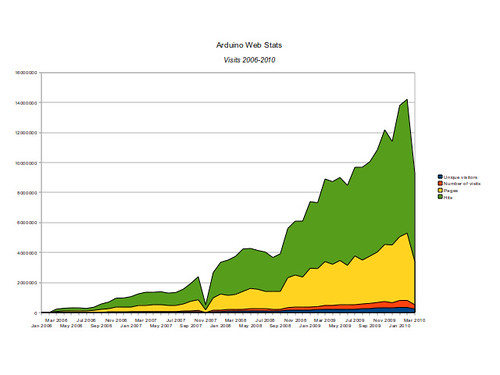MOTORUINO VS ROBODUINO, THE BATTLE OF ROBOTS
– April 30th, 2010


We previously covered the Motoruino project from Lisbon-based makerGuilherme Martins; some days ago I’ve seen another nice kit from Canadian Robotshop, called Roboduino. The dawn of the age of robot…
Video of both platform in action after the break.
UPDATE: [Julien] submitted a mistake I did in the embedding of images. The first image here is picturing a Romeo from Korean DFRobot. The true (yet very similar) roboduino is this.

MORE ON ARDUINO SYNTH
– April 29th, 2010

Some time ago we posted an odd video about an arduino-based synth. [DeFex] (arduino forum user) revealed a nice PCB design to get it shielded:
The arduino is a 4 oscillator phase accumulator, and does a few other things.each oscillator has a separate DAC which are mixed in the analog realm (controlling an 8 bit DAC level with another 8 bit signal gives a lot better resolution than changing its level digitally)The levels of the DACs are controlled VIA PWM > 4 pole filter > Vref. and then the DAC output is level converted to +- rather then +Each pair of DACs has another 4 pole filter on the output to eliminate any aliasing.And yet another 4 pole filter on an aux envelope out.There are 2 Multiplexers (completely copied from the mux shield) which get the values for 32 potentiometers which control various modulation and wavetable selection etc.There are no voltage controlled filters on board, but it can output envelopes and triggers for modular synth filters/analog envelope generatorsAnd 2 inputs for external control voltages through a special ADA4091-2 op amp which can take +_25v over the rail input, and being powered by the arduino power, it automagically protects the inputs from the higher voltages existing in a modular synth (+- 15v)I am planning to make a cut down version which would fit on a proper shield, but i still need to experiment a bit (especially trying to make a nice sounding 5 volt voltage controlled filter!) but it will still have to be a mega.I will continue posting as it is built and tested along the way.
so far i attached the arduino and made sure the signals and power are going to all the proper places.
via [Arduino Forum]
BALL BALANCE MACHINE
– April 29th, 2010
This is an impressive use of Arduino, two servos, a webcam and Processing to tilt a ball platform.
Via [MAKE]
YEAH, WE WENT TO NYC!
– April 29th, 2010
It is now a month since the Arduino Uno meetup at ITP finished, I have been busy as hell (and I still am), but it feels it is time to report back to the community about my share of what happened there. We -the Arduino team- had to meet for our yearly discussion about how to move on with the project. It is just that it was our 5th anniversary, so it felt like we had to make something special. We prepared a selection of talks and topics we felt had to be discussed with everybody and we brought things up to a series of people. We had to chose between making “the Arduino conference” or making something a little more intimate that would gather representatives from the community, the distribution list, the users, teachers, and people developing products on top of our technology.
We tried to get people from all over to NYU (New York University, our host) and spent two days in a series of marathonian sessions about IDE improvements, API enhancements, library compatibility, board redesign ideas, business models, and web 3.0. I am actually really proud of the Spanish speaking community, represented by Igor Gonzalez, from Spain, who gathered everyone’s opinions throughout the forum and brought up important matters that concern the way we should design our new online services to make them more inclusive to non-English speaking people. The meeting closed up with an open day where anyone was welcome to pass by, bring their project along and share with the rest.
I took the chance to prepare things for the talk about the web, I made sure I had a series of good graphs to show, and those are the ones I really itch to show you guys. The web has experienced an explosion in the amount of visitors since we started, and it feels it will only grow. I think I expressed in an earlier post my personal obsession in having 100% uptime for our web services, so that people can rely on us for education, sharing knowledge with others, and document the outcome of their projects. Looking at this statistics, I started to understand that … if we started to work with high-schools and not only with universities, we should address a completely different set of issues like the size (probably we will multiply by 10 our network use in a matter of months), safety, user privacy (you don’t want your kids’ information to be misused on the internet, right?), and of course: COOLNESS FACTOR!
I added this mission to my list of things to study as part of my PhD at Malmo University and scheduled a meeting at Google, thanks to an ITP alumni (Laura thanks a bunch for arranging it!) where I exposed mine and Arduino’s concerns about our future on the web. During a 1 hour presentation and a 1 hour lunch meeting some people at Google NYC and I came to understand a possible model for bringing Arduino to work on their cloud infrastructure. For those that don’t know about it, Google offers scalable infrastructure on Python and Java for free up to a certain amount of hits/month. As for today we are already over their limit, but they are really flexible when it comes to open source projects.
However, the conversation about the web has just started, and will last for some time. I want to understand the implications of migrating from a VPS/dedicated server structure to a cloud one. I have read a lot in the weeks following to the March meeting in NY and it is my understanding the cloud makes sense up to a point. What would happened if we spent e.g. 1 year developing a whole new web infrastructure and all of the sudden we had to migrate to our own series of dedicated servers because of the size we would have reached. This is when I need to talk more about it, I will go back to the Google people, who have been super helpful so far. But I will also analyze others like Amazon who offer a linux transparent cloud that would allow for faster migrations, at least is how I understood their system.
ARDUINO ANT FARM
– April 28th, 2010
Amazing project from [Adam Franchino], via [MAKE]
I went to the RobotFest / Mid-Atlantic Mini Maker Faire yesterday. I saw this awesome project and thought you might like to put it on the blog. Basically it’s an ant farm with optointerrupts. When the ants walk through the lightpath, they modify the audio output. The maker’s name is Adam Franchino, and he was there with some of his classmates from the Maryland Institute College of Art (MICA) His website is adamfranchino.net.
from [MAKE] source [Adam Franchino]
A VIRTUAL USB KEYBOARD SHIELD IS BORN
– April 28th, 2010

[Jonathan Oxer] from Practical Arduino discovered a shield made on his Virtual USB Keyboard project:
I don’t know anything much about it other than what’s shown on that page, but from what I can deduce it’s the circuit from the Virtual USB Keyboardproject converted into a nice PCB with a bunch of buttons included for controlling games running under the arcade machine emulator MAME.
via [Practical Arduino]
FLOPPY DRIVES, ARDUINO BOARD MANGLED INTO AUDIO DELAY EFFECTS
– April 28th, 2010

[Michael Una] posted nice review on the ongoing Floppy Audio Effects Project on Create Digital Music:
This year, you can add 3.5? floppy drives and disks to your shopping list, courtesy of Daniel McAnulty’s project Floppy Audio Effects. Dan figured out a couple of neat tricks to create delay/reverb effects by writing audio to the disks directly, then reading that information back using a tape head.
TWITWEE CLOCK TWEETS YOUR TWEETS
– April 27th, 2010

What would be the most apt way to notify someone when they have a new Tweet? Why through the chirps of a cuckoo clock of course.Heidelberg-based designer Haroon Baig has modified a traditional cuckoo clock adding an Arduino board, custom software and a touchscreen display to create the Twitwee clock.
(cool) Video after the break.
GETTING STARTED WITH ARDUINO – #0
– April 27th, 2010

If tou really want to take a step by step tour on the Arduino, you really should look after this John Boxall post.
During these series of posts, we will refer to the Arduino website, and the book:
- Getting Started with Arduino (Massimo Banzi)
and also assume a basic knowledge of electronics. I can recommend the following book for such information:
- Make: Electronics (Chales Platt)
He starts a series of tutorial about some Arduino Skecthes, introducing the Night Rider effect in the firs one.
Read the rest of this entry »
Read the rest of this entry »
SOLDERING IS EASY – COMIC ADAPTATION BY MITCH ALTMAN
– April 27th, 2010

[...] I [Andie] wanted to pass that on, and thought a comic adaptation could work to teach it, and that having 1 page of instructions that could be pinned to the wall next to soldering stations in hackerspaces, handed out at workshops, or just used to refresh the basics would be a good idea. So here it is – 1 page on how easy soldering is, and how to do it. It assumes you have the tools and kit/parts you need, and a basic idea of what soldering is and why you’d want to do it.












0 comentarios:
Publicar un comentario